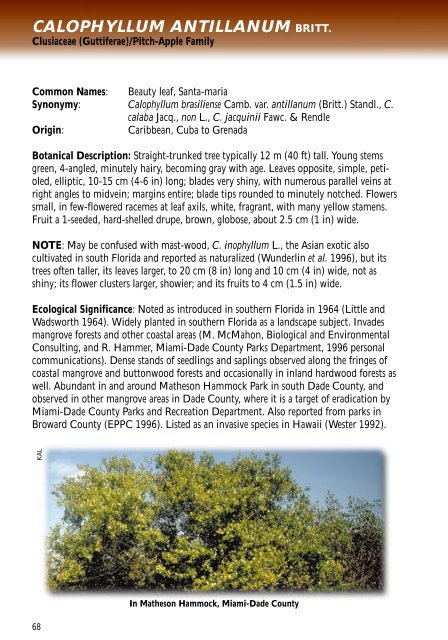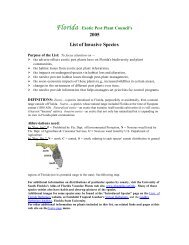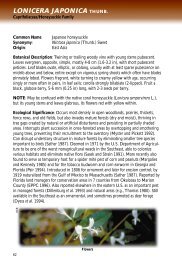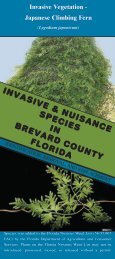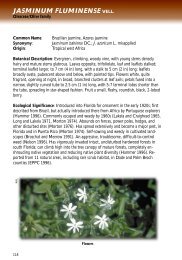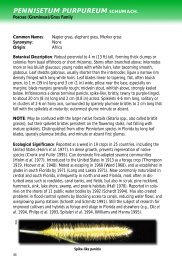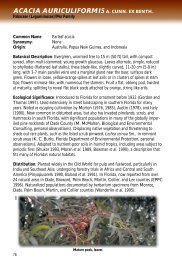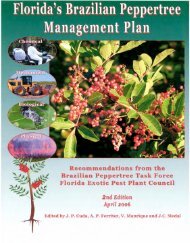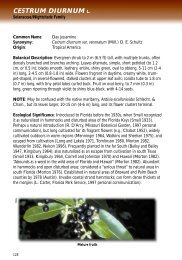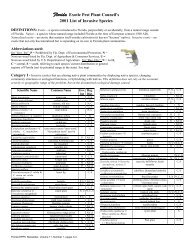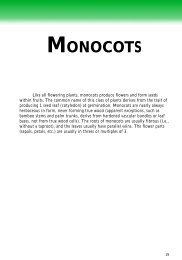DICOTS - Florida Exotic Pest Plant Council
DICOTS - Florida Exotic Pest Plant Council
DICOTS - Florida Exotic Pest Plant Council
You also want an ePaper? Increase the reach of your titles
YUMPU automatically turns print PDFs into web optimized ePapers that Google loves.
Calophyllum antillanum Britt.<br />
Clusiaceae (Guttiferae)/Pitch-Apple Family<br />
Common Names: Beauty leaf, Santa-maria<br />
Synonymy: Calophyllum brasiliense Camb. var. antillanum (Britt.) Standl., C.<br />
calaba Jacq., non L., C. jacquinii Fawc. & Rendle<br />
Origin: Caribbean, Cuba to Grenada<br />
Botanical Description: Straight-trunked tree typically 12 m (40 ft) tall. Young stems<br />
green, 4-angled, minutely hairy, becoming gray with age. Leaves opposite, simple, petioled,<br />
elliptic, 10-15 cm (4-6 in) long; blades very shiny, with numerous parallel veins at<br />
right angles to midvein; margins entire; blade tips rounded to minutely notched. Flowers<br />
small, in few-flowered racemes at leaf axils, white, fragrant, with many yellow stamens.<br />
Fruit a 1-seeded, hard-shelled drupe, brown, globose, about 2.5 cm (1 in) wide.<br />
NOTE: May be confused with mast-wood, C. inophyllum L., the Asian exotic also<br />
cultivated in south <strong>Florida</strong> and reported as naturalized (Wunderlin et al. 1996), but its<br />
trees often taller, its leaves larger, to 20 cm (8 in) long and 10 cm (4 in) wide, not as<br />
shiny; its flower clusters larger, showier; and its fruits to 4 cm (1.5 in) wide.<br />
Ecological Significance: Noted as introduced in southern <strong>Florida</strong> in 1964 (Little and<br />
Wadsworth 1964). Widely planted in southern <strong>Florida</strong> as a landscape subject. Invades<br />
mangrove forests and other coastal areas (M. McMahon, Biological and Environmental<br />
Consulting, and R. Hammer, Miami-Dade County Parks Department, 1996 personal<br />
communications). Dense stands of seedlings and saplings observed along the fringes of<br />
coastal mangrove and buttonwood forests and occasionally in inland hardwood forests as<br />
well. Abundant in and around Matheson Hammock Park in south Dade County, and<br />
observed in other mangrove areas in Dade County, where it is a target of eradication by<br />
Miami-Dade County Parks and Recreation Department. Also reported from parks in<br />
Broward County (EPPC 1996). Listed as an invasive species in Hawaii (Wester 1992).<br />
KAL<br />
68<br />
In Matheson Hammock, Miami-Dade County


